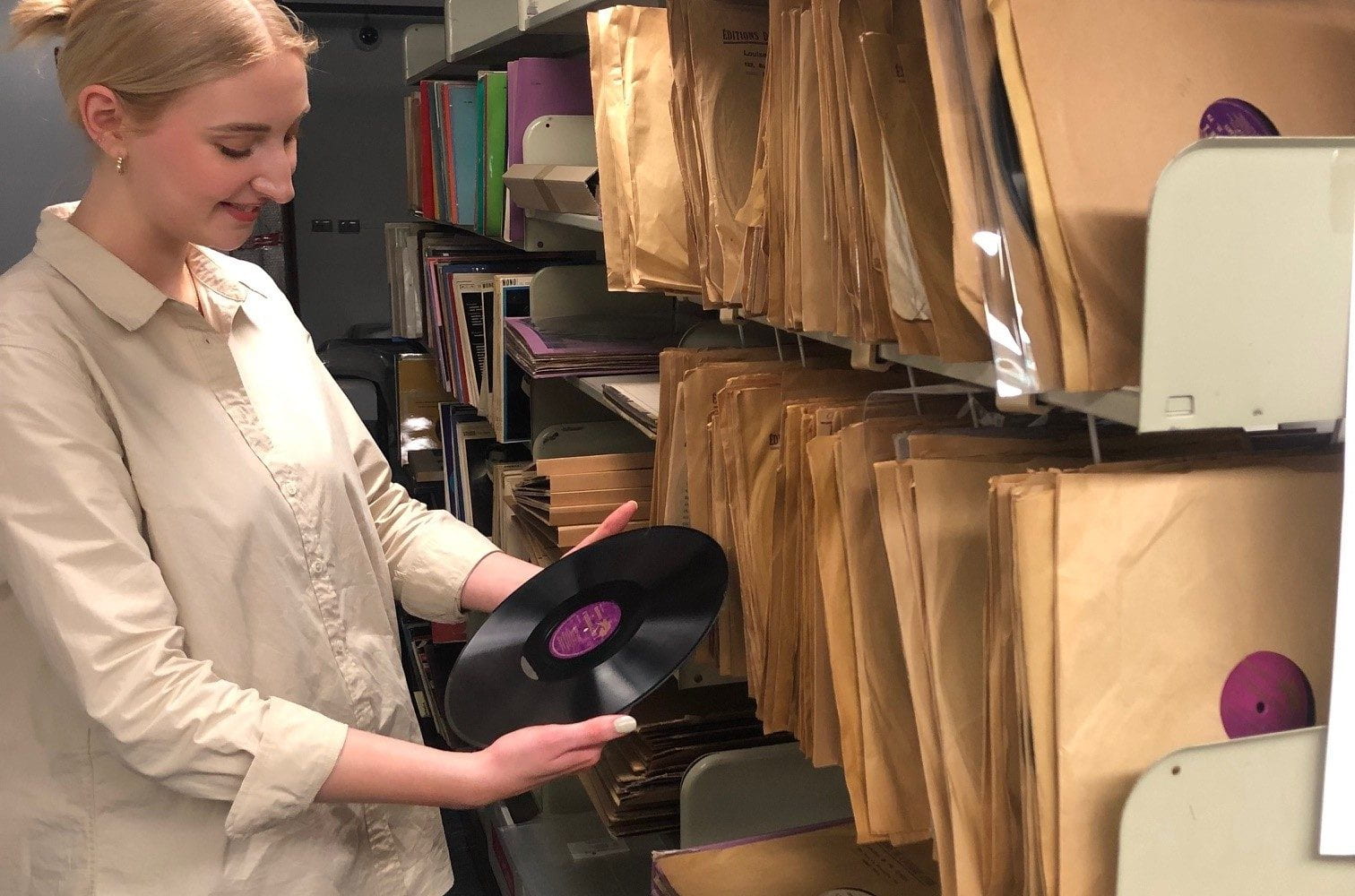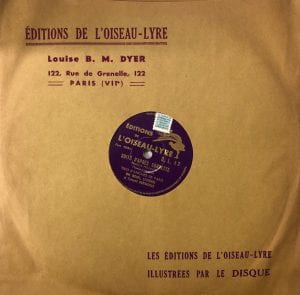
Interview with Madeline Roycroft on the Éditions de l’Oiseau-Lyre Archive
Madeline Roycroft is working as a Research Assistant in the Louise Hanson-Dyer collection, which sits within our Rare Music collection. Madeline is also currently a Grainger Teaching Fellow, coordinates Context, a music research journal at the Melbourne Conservatorium of Music and has just submitted her PhD thesis on the reception of the Soviet composer Dmitri Shostakovich in twentieth-century France. Recently, I sat down with Madeline to learn more about her work in Archives and Special Collections.
What is the project you are currently working on in the Rare Music collection?
I’m using the Éditions de l’Oiseau-Lyre Archive, housed in the Rare Music collection, to build a database on the professional network of Louise Hanson-Dyer. Hanson-Dyer was an Australian patron of the arts who established her own publishing press (Les Éditions de l’Oiseau-Lyre) in Paris in 1932. The label initially specialised in producing fine editions of early and baroque music that had never previously been published, but Hanson-Dyer also published the music of contemporary composers, and from 1938 she employed many musicians from around Europe to record the music she published.
The database I am working on documents not only who worked on each publication and when, but also the relationships between people who worked on each publication. For example, for a sound recording featuring three musicians, I have recorded collaborations between Person 1 and Person 2, Person 1 and Person 3, and Person 2 and Person 3, as well as relationships between Hanson-Dyer and each musician (as she engaged each of them to record on her label), and so on. The database at present has over 600 publications and roughly 2,200 relationships! The next step is to collaborate again with the Melbourne Data Analytics Platform (they helped us with the original set-up of the project) to turn this metadata into an interactive map of Hanson-Dyer’s professional network, which may be useful for researchers working across a variety of areas, such as twentieth-century music composition and publishing, patronage, women in the arts, early recordings, etc.

What would you like people to know about Louise Hanson-Dyer, that you’ve discovered in your time on this project?
Hanson-Dyer is sometimes viewed only as a patron of the arts, which does not account for the work she put into the operations of Les Éditions de l’Oiseau-Lyre. Hanson-Dyer was not only a source of funds for artists: she was a businesswoman and music publisher with a keen eye for talent and detail. She basically controlled everything, and engaged the best musicologists, performers, sound technicians, engravers, bookbinders and printers to assist with her publishing and recording endeavours. Hanson-Dyer also wanted her publications to serve a timeless aesthetic purpose as well as a musical one: the 12-volume Couperin set, for example, features a striking Art Deco cover design by Rose Adler; the Polyphonies du XIIIe siècle were published with covers made of fine Australian blackwood; while the labels of the 78s feature gold foil against Hanson-Dyer’s favourite shade of purple.
When you are not working at ASC, what other projects are you working on?
I have very recently submitted the project that has kept me busy for the last six years – my PhD thesis! I looked at the reception of the Soviet composer Dmitri Shostakovich in twentieth-century France, which involved translating and analysing hundreds of press sources that discussed Shostakovich’s music between 1930 and 2000. I found that the attitudes of French critics towards Shostakovich tended to evolve in line with the shifting relations between France and the Soviet Union, and also documented how his music was championed by the French Communist Party, particularly in the 1930s and ’40s but also at the time of the Soviet Union’s restructuring in 1989. While I await the examiner reports, I have been editing articles for the new issue of Context, the music research journal I coordinate at the MCM, as well as beginning a proposal for the book I hope to publish based on the material in my thesis.
What current musicians, composers and labels are you excited about in the Australian or international music scene?
This isn’t exactly current but I am excited to play oboe in the orchestra for Wagner’s Ring Cycle in Bendigo next year. It will be the first time that this cycle (of four operas) has been performed in regional Australia, so that’s something special for musical life in Australia in 2023.
Beyond the world of classical music, one of my favourite artists Stromae released a new album earlier this year (after a long hiatus) and I’m still obsessed with it. Stromae is a Belgian artist known mainly for rap and Europop, but the new album borrows instruments and rhythms from diverse musical traditions yet the lyrics cover profound and personal subjects – it’s both very moving and very cool. I will be in Europe during some of his tour in 2023 so I’m hoping I can see a live show.
About the Collection:
In 2013, the Monaco-based music publisher Éditions de l’Oiseau-Lyre (Lyrebird Press), established by Louise Hanson-Dyer in 1932, closed and its archive arrived at the University. It includes business records and correspondence, including letters from leading composers, artists and writers. There are also personal papers, Louise Hanson-Dyer’s memorabilia, her own library and some artworks. The archive features a “President’s Collection” (previously shelved together in Monaco) comprising one copy of almost every one of the Press’s print publications; a substantial collection of other music manuscript scores, many in the composer’s hand; and printed scores and performance parts. There are also 78 and 33 1/3 rpm audio recordings, publication proofs and press clippings. The Editions de l’Oiseau-Lyre archive promises significant new insights into one of the twentieth century’s most important music publishing houses and is an important resource for researchers. You can learn more about the collection here.
Chelsea Harris
Coordinator, Communications and Engagement
Leave a Reply